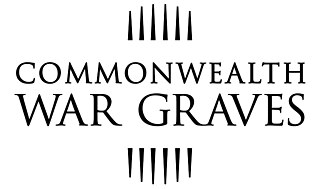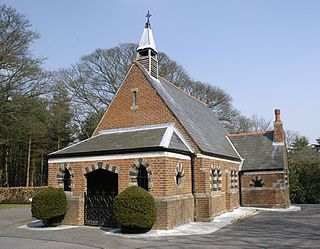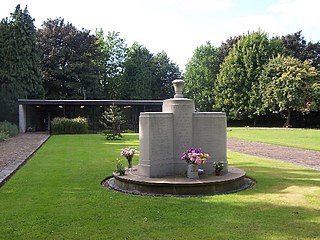
The Commonwealth War Graves Commission (CWGC) is an intergovernmental organisation of six independent member states whose principal function is to mark, record and maintain the graves and places of commemoration of Commonwealth of Nations military service members who died in the two World Wars. The commission is also responsible for commemorating Commonwealth civilians who died as a result of enemy action during the Second World War. The commission was founded by Sir Fabian Ware and constituted through Royal Charter in 1917 as the Imperial War Graves Commission. The change to the present name took place in 1960.

Brookwood Cemetery, also known as the London Necropolis, is a burial ground in Brookwood, Surrey, England. It is the largest cemetery in the United Kingdom and one of the largest in Europe. The cemetery is listed a Grade I site in the Register of Historic Parks and Gardens.

The Cross of Sacrifice is a Commonwealth war memorial designed in 1918 by Sir Reginald Blomfield for the Imperial War Graves Commission. It is present in Commonwealth war cemeteries containing 40 or more graves. Its shape is an elongated Latin cross with proportions more typical of the Celtic cross, with the shaft and crossarm octagonal in section. It ranges in height from 18 to 24 feet. A bronze longsword, blade down, is affixed to the front of the cross. It is usually mounted on an octagonal base. It may be freestanding or incorporated into other cemetery features. The Cross of Sacrifice is widely praised, widely imitated, and the archetypal British war memorial. It is the most imitated of Commonwealth war memorials, and duplicates and imitations have been used around the world.

The Kranji War Memorial is located at 9 Woodlands Road, in Kranji in northern Singapore. Dedicated to the men and women from the United Kingdom, Australia, Canada, Sri Lanka, India, Malaya, the Netherlands and New Zealand who died defending Singapore and Malaya against the invading Japanese forces during World War II, it comprises the War Graves, the Memorial Walls, the State Cemetery, and the Military Graves.

Groesbeek Canadian War Cemetery and Memorial is a Second World War Commonwealth War Graves Commission military war grave cemetery, located in the village of Groesbeek, 8 km (5.0 mi) southeast of Nijmegen in the Netherlands. Of the total 2,619 burials, the cemetery contains 2,338 Canadian soldiers. It was built to a design by Commission architect Philip Hepworth.

Sai Wan War Cemetery is a military cemetery located in Chai Wan, Hong Kong which was built in 1946. The cemetery was created to commemorate soldiers of Hong Kong Garrison who perished during the Second World War. The cemetery also contains 12 World War I burials. A total of 1,528 soldiers, mainly from the Commonwealth, are commemorated here. Most of the remaining burials are located at the Stanley Military Cemetery.

Aldershot Military Cemetery is a burial ground for military personnel, or ex-military personnel and their families, located in Aldershot Military Town, Hampshire.

Harrogate (Stonefall) Cemetery is a Commonwealth War Graves Commission (CWGC) burial ground for the dead of the First World War and Second World War located on the outskirts of Harrogate in North Yorkshire, England.

The Arnhem Oosterbeek War Cemetery, more commonly known as the Airborne Cemetery, is a Commonwealth War Graves Commission cemetery in Oosterbeek, near Arnhem, the Netherlands. It was established in 1945 and is home to 1764 graves from the Second World War besides 4 later non-war graves and there are special memorials of two personnel buried elsewhere. Most of the men buried in the cemetery were Allied servicemen killed in the Battle of Arnhem, an Allied attempt to cross the Rhine in 1944, or in the liberation of the city the following year. Men killed in these battles are still discovered in the surrounding area even in the 21st century, and so the number of people interred in the cemetery continues to grow.

The South Stoneham municipal cemetery, situated off Mansbridge Road, Southampton, was opened in early 1905, with the first burial taking place on 4 February, and was extended in 1927. The South Stoneham Crematorium was located north of the cemetery but demolished during 1973 to make way for the construction of the M27 motorway. The South Stoneham garden of remembrance is now located at the north end of the cemetery.
During World War II, the Netherlands was the scene of five years of continuous air warfare between the Allied and the Nazis as the Netherlands lies en route from England to Germany and was designated and built up as the foremost line of Nazi air defence of Germany. Also, in 1944 there was heavy land fighting during the largest Allied airborne attack of the WWII in the south and east of the country in 1944–45. Thousands of airmen, soldiers and others of many nations were killed, and their war graves in some 4,000 locations are in the care of the Dutch War Cemetery Organisation.

Beechwood Cemetery is the national cemetery of Canada, located in Vanier, Ottawa, Ontario. Over 82,000 Canadians from all walks of life are buried in the cemetery, including Governor General Ramon Hnatyshyn, Prime Minister Robert Borden, and several members of Parliament, premiers, Canadian Armed Forces personnel and veterans, Royal Canadian Mounted Police personnel, Canadian Security Intelligence Service intelligence officers, and Hockey Hall of Famers, alongside other notable Canadians. In addition to being Canada's national cemetery, it is also the national military cemetery of Canada and the national memorial cemetery of the RCMP.

Essex Farm Cemetery is a World War I, Commonwealth War Graves Commission burial ground within the John McCrae Memorial Site near Ypres, Belgium. There are 1,204 dead commemorated, of which 104 are unidentified. The cemetery was designed by Sir Reginald Blomfield and has an area of 6,032 square metres (64,930 sq ft).

The Gibraltar Cross of Sacrifice is a war memorial in the British Overseas Territory of Gibraltar. It is located west of North Front Cemetery, at the junction of Winston Churchill Avenue and Devil's Tower Road. The Cross of Sacrifice was designed by Sir Reginald Blomfield in 1917, and his monument is found in numerous Commonwealth War Graves Commission cemeteries. The cross in Gibraltar was erected by the Royal Engineers for the commission, and unveiled on Armistice Day 1922. The British Pathé film recorded at the dedication ceremony that day represents the first motion picture made in Gibraltar. The Gibraltar Cross of Sacrifice served as the focus of Remembrance Sunday ceremonies in Gibraltar until 2009, at which time the location was changed to the Gibraltar War Memorial.

The United Nations Memorial Cemetery in Korea, located at Tanggok in the Nam District, City of Busan, Republic of Korea, is a burial ground for United Nations Command (UNC) casualties of the Korean War. It contains 2,300 graves and is the only United Nations cemetery in the world. Laid out over 14 hectares, the graves are set out in 22 sites designated by the nationalities of the buried servicemembers.

Pilot Officer Geoffrey Lloyd Wells Memorial Seat is a heritage-listed memorial at 103 Stanley Terrace, Taringa, City of Brisbane, Queensland, Australia. It was designed by the Wells Family in honour of their son Pilot Officer Geoffrey Lloyd Wells. It was built some time after August 1941 by Wells Family. It was added to the Queensland Heritage Register on 21 October 1992.

Yokohama War Cemetery is a military cemetery in Hodogaya-ku, Yokohama, in Japan and located next to Yokohama Municipal Children's Botanical Garden.

Liberation Route Europe is an international remembrance trail that connects the main regions along the advance of the Western Allied Forces toward the liberation of Europe and final stage of the Second World War. The route started in 2008 as a Dutch regional initiative in the Arnhem-Nijmegen area and then developed into a transnational route that was officially inaugurated in Arromanches on June 6, 2014, during the Normandy D-day commemorations. The route goes from Southern England through France, Belgium, Luxembourg, the Netherlands to Berlin in Germany, then extends to the Czech Republic and Poland. The southern route starts in Italy. As a form of remembrance tourism, LRE aims to unfold these Allied offensives of 1944 and 1945 in one narrative combining the different perspectives and points of view. By combining locations with personal stories of people who fought and suffered there, it gives visitors the opportunity to follow the Allied march and visit significant sites from war cemeteries to museums and monuments but also events and commemorations. In April 2019, Liberation Route Europe became a certified Cultural Route of the Council of Europe.

The Delhi War Cemetery, in the Delhi Cantonment, Delhi, India, is the site of the graves of 1,154 service personnel who served the British Empire during the First and Second World Wars. The cemetery was established in 1951 to ensure the permanent preservation of the remains of soldiers across various cemeteries in northern India.

Mailly Wood Cemetery is a military cemetery with casualties from the First World War, located in the French village of Mailly-Maillet (Somme). It is maintained by the Commonwealth War Graves Commission.





















